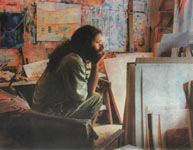  Downtown Hotels, Offices, Arena Squeeze Out Artists With High Rents Downtown Hotels, Offices, Arena Squeeze Out Artists With High Rents  By Chris Baker By Chris Baker
Washington Times
September 25, 2000
The Downtown Arts District in Washington has offices, hotels and a sports arena, but few artists.
It hasn't always been this way. For years, cheap studio rent and proximity to the downtown galleries and theaters brought painters, photographers and sculptors to the city's designated arts district, roughly defined as a 10-block swath in Northwest framed by G Street to the north, Sixth Street to the east, Pennsylvania Avenue to the south and 14th Street to the west.
But the economic resurgence that has made the District a destination for businesses for the first time since the 1960s is pushing artists out of downtown.
Some artists are moving because of soaring rents. In other cases, landlords are evicting artists and other tenants in order to build new office and retail space, which can fetch between 50 percent and 60 percent more in monthly rent than what the typical artist can pay, according to real estate brokers.
"There was a time when the arts community was entrenched in downtown D.C., but those days are over," said Anne Corbett, executive director of the D.C. Cultural Development Corp., a private group that pushes developers to incorporate arts space in their projects. Ms. Corbett estimates that as many as 200 artists had studio and exhibition space in downtown in the 1980s. Today, 97 percent of those artists are gone and their space has been replaced by the more lucrative office and retail space, she said.
The most dramatic change has unfolded along F Street NW, a haven for local artists since the late 19th century, when museum founder William Corcoran rented studio space in a building at 15th and F streets. Today, F Street is being transformed into an office corridor. The owners of several buildings that once housed studios have evicted their tenants and redeveloped their property.
On F Street's 900 block, the Atlas and Atlantic buildings — which housed studios for years — are being renovated as office space.
Meanwhile, the Catholic Church, which owns a string of eight low-rises on the block, is planning to demolish the town house-style buildings to build an 11-floor office building. Michael Berman, a painter who pays about $500 a month for 600 square feet of space in one of the church-owned low-rises, said he is one of about 15 artists left on the block."There is so much history here, [but] when we're gone, that's it," he said.
Battling redevelopment
Mr. Berman has formed a group, the Downtown Artists Coalition, that is suing the church to stop the $50 million office building, dubbed Carroll Square. Preservationists have joined the fight, saying the old buildings are the last bit of 19th-century architecture left in downtown.
David Bell, president of the D.C. Preservation Society, said replacing the buildings with the Carroll Square complex will turn the block into a sterile office corridor that is lifeless in the evenings and on weekends.
Under the church's plan, the facades of seven of the buildings it plans to tear down would be preserved to meet the District's requirements governing historic buildings. A D.C. administrative law judge denied the church's request for demolition permits last November, ruling the project was inconsistent with the Historic District Preservation Act of 1978. But earlier this year, the church's lawyers found a loophole in the city's regulatory code that forced the District to issue the permits because the judge took longer than 60 days to make his decision.
Church leaders have said they want to replace the F Street low-rises with office space because it would fetch higher rents and generate more funding for church programs.
Stuart Gosswein, a painter who leases studio space in one of the church-owned buildings, said he pays rent on a month-to-month basis, never knowing when the church may tell him to leave. "This is my livelihood. . . . I need to be in a commercial district [where] my clients can find me easily," he said.
John E. Akridge III, the developer the church has hired to build Carroll Square, said it is "entirely possible" the new building will feature studio space for artists.
Mr. Akridge said he and church leaders will meet with the artists and the Preservation League to try to reach a compromise."There are a lot of pieces of the puzzle and they are all in play right now," he said.
Beyond downtown
The problems facing the downtown artists have also surfaced in other parts of the District.
In Northeast, sculptor Randy Jewart believes the city's efforts to lure high-technology companies to his neighborhood will jack up the rent for current tenants.
Mr. Jewart's studio is on N Street, in the heart of what District officials call "NoMa" because it is the area north of Massachusetts Avenue. The city believes young techies will want to move to NoMa because it is home to warehouses and retro-style buildings that give it an urban, funky feel — not unlike SoHo in New York.
Those warehouses have also attracted people like Mr. Jewart, who estimates he is one of 50 working artists in the neigh-borhood.
Although several tech companies — including XM Satellite Radio Holdings Inc. — have already leased buildings in NoMa, Mr. Jewart said his landlord hasn't raised his rent.He expects that to change soon."I can stand on my roof and throw a rock and hit a billion-dollar satellite company, so yeah, I'm pretty sure my rent will be going up eventually," Mr. Jewart said.
Ms. Corbett, the executive director of the D.C. Cultural Development Corp., said she hopes the artists and the tech companies in NoMa will be able to coexist."We hope they will feed off each other," she said, noting that more visual artists are using computer graphics to create their work.
Seeking solutions
D.C. Mayor Anthony A. Williams, a Democrat, has included several arts-related proposals in his plan to redevelop the area surrounding the Washington Convention Center at 900 Ninth St. NW. The mayor has said he wants to create an "arts walk" to link the galleries along Seventh Street NW and to establish more joint "live-work" spaces for artists in the city.
Some artists said the mayor and other city leaders haven't done enough to support them." The city has not done anything strategically to protect artists. They've talked about it a lot," Ms. Corbett said.
D.C. Council member Jack Evans, a Democrat whose Ward 2 constituency includes the city-designated Downtown Arts District, has endorsed Carroll Square, the proposed office complex on F Street.But even if he didn't support it, Mr. Evans said there is little he could do to stop Carroll Square since it is a matter between a private landlord and its tenants.
Top
Back to News |

